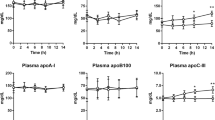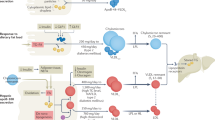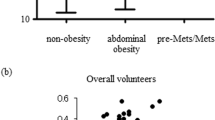Abstract
Objective:
To compare the effect of a high monounsaturated fatty acid (MUFA) diet and of a control low-fat diet consumed under ad libitum conditions on plasma apolipoprotein (apo) C-III metabolism.
Design:
Randomized, two-arm parallel dietary trial.
Setting:
Diets were prepared and consumed at the metabolic kitchen of the Department of Food Sciences and Nutrition, and laboratory analyses were performed at the Institute of Nutraceuticals and Functional Foods at Laval University.
Subjects and interventions:
Eighteen men were randomly assigned to either the high MUFA diet or the low-fat control diet, which they consumed for 6–7 weeks. Before and after the dietary intervention, subjects received a primed-constant infusion of [5,5,5-D3]-L-leucine for 12 h under constant feeding conditions for the determination of plasma apoC-III kinetics.
Results:
The high-MUFA diet and the low-fat control diet had no significant impact on plasma apoC-III production rate (PR) or fractional catabolic rate. However, diet-induced variations in plasma apoCIII PR predicted the reduction in plasma triglycerides and apoC-III levels (r=0.85, P<0.01 and r=0.73, P<0.05, respectively) in the high MUFA group only.
Conclusions:
These results suggest that the hypotriglyceridemic effect of a high-MUFA diet may be attributable in part to a reduced hepatic production of apoC-III.
Sponsorship:
This study was supported in part by an operating grant from the Canadian Institutes of Health Research (CIHR), and the Canada Research Chair in Nutrition and Cardiovascular Health (B Lamarche).
This is a preview of subscription content, access via your institution
Access options
Subscribe to this journal
Receive 12 print issues and online access
$259.00 per year
only $21.58 per issue
Buy this article
- Purchase on Springer Link
- Instant access to full article PDF
Prices may be subject to local taxes which are calculated during checkout

Similar content being viewed by others
References
Archer WR, Desroches S, Lamarche B, Deriaz O, Landry N, Fontaine-Bisson B et al. (2005). Variations in plasma apolipoprotein C-III levels are strong correlates of the triglyceride response to a high-monounsaturated fatty acid diet and a high-carbohydrate diet. Metabolism 54, 1390–1397.
Archer WR, Lamarche B, Deriaz O, Landry N, Corneau L, Despres JP et al. (2003a). Variations in body composition and plasma lipids in response to a high-carbohydrate diet. Obes Res 11, 978–986.
Archer WR, Lamarche B, St Pierre AC, Mauger JF, Deriaz O, Landry N et al. (2003b). High carbohydrate and high monounsaturated fatty acid diets similarly affect LDL electrophoretic characteristics in men who are losing weight. J Nutr 133, 3124–3129.
Austin MA (1999). Epidemiology of hypertriglyceridemia and cardiovascular disease. Am J Cardiol 83, 13F–16F.
Bower JF, Deshaies Y, Pfeifer M, Tanenberg RJ, Barakat HA (2002). Ethnic differences in postprandial triglyceride response to a fatty meal and lipoprotein lipase in lean and obese African American and Caucasian women. Metabolism 51, 211–217.
Brousseau ME, Ordovas JM, Osada J, Fasulo J, Robins SJ, Nicolosi RJ et al. (1995). Dietary monounsaturated and polyunsaturated fatty acids are comparable in their effects on hepatic apolipoprotein mRNA abundance and liver lipid concentrations when substituted for saturated fatty acids in cynomolgus monkeys. J Nutr 125, 425–436.
Chan DC, Watts GF, Nguyen MN, Barrett PH (2006). Apolipoproteins C-III and A-V as predictors of very-low-density lipoprotein triglyceride and apolipoprotein B-100 kinetics. Arterioscler Thromb Vasc Biol 26, 590–596.
Chan DC, Watts GF, Redgrave TG, Mori TA, Barrett PH (2002). Apolipoprotein B-100 kinetics in visceral obesity: associations with plasma apolipoprotein C-III concentration. Metabolism 51, 1041–1046.
Cobelli C, Toffolo G, Foster DM (1992). Tracer-to-tracee ratio for analysis of stable isotope tracer data: link with radioactive kinetic formalism. Am J Physiol 262, E968–E975.
Cohn JS, Patterson BW, Uffelman KD, Davignon J, Steiner G (2004a). Rate of production of plasma and very-low-density lipoprotein (VLDL) apolipoprotein C-III is strongly related to the concentration and level of production of VLDL triglyceride in male subjects with different body weights and levels of insulin sensitivity. J Clin Endocrinol Metab 89, 3949–3955.
Cohn JS, Tremblay M, Batal R, Jacques H, Rodriguez C, Steiner G et al. (2004b). Increased apoC-III production is a characteristic feature of patients with hypertriglyceridemia. Atherosclerosis 177, 137–145.
Couillard C, Vohl MC, Engert JC, Lemieux I, Houde A, Almeras N et al. (2003). Effect of apoC-III gene polymorphisms on the lipoprotein-lipid profile of viscerally obese men. J Lipid Res 44, 986–993.
Desroches S, Paradis ME, Perusse M, Archer WR, Bergeron J, Couture P et al. (2004). Apolipoprotein A-I, A-II, and VLDL-B-100 metabolism in men: comparison of a low-fat diet and a high-monounsaturated fatty acid diet. J Lipid Res 45, 2331–2338.
Ford ES, Giles WH, Dietz WH (2002). Prevalence of the metabolic syndrome among US adults. Findings from the Third National Health and Nutrition Examination Survey. J Am Med Assoc 287, 356–359.
Huff MW, Nestel PJ (1982). Metabolism of apolipoproteins CII, CIII1, CIII2 and VLDL-B in human subjects consuming high carbohydrate diets. Metabolism 31, 493–498.
Kliewer SA, Sundseth SS, Jones SA, Brown PJ, Wisely GB, Koble CS et al. (1997). Fatty acids and eicosanoids regulate gene expression through direct interactions with peroxisome proliferator-activated receptors alpha and gamma. Proc Natl Acad Sci USA 94, 4318–4323.
Kotite L, Bergeron N, Havel RJ (1995). Quantification of apolipoproteins B-100, B-48, and E in human triglyceride-rich lipoproteins. J Lipid Res 36, 890–900.
Lohman T, Roche A, Martorel R (1988). The Airlie (VA) consensus conference. In: Standardization of anthropometric measurements. Human Kinetics Publisher, Champaign, IL, pp 39–80.
Malmendier CL, Lontie JF, Delcroix C, Dubois DY, Magot T, De Roy L (1989). Apolipoproteins C-II and C-III metabolism in hypertriglyceridemic patients. Effect of a drastic triglyceride reduction by combined diet restriction and fenofibrate administration. Atherosclerosis 77, 139–149.
Mauger JF, Couture P, Paradis ME, Lamarche B (2005). Comparison of the impact of atorvastatin and simvastatin on apoA-I kinetics in men. Atherosclerosis 178, 157–163.
Onat A, Hergenc G, Sansoy V, Fobker M, Ceyhan K, Toprak S et al. (2003). Apolipoprotein C-III, a strong discriminant of coronary risk in men and a determinant of the metabolic syndrome in both genders. Atherosclerosis 168, 81–89.
Ruel IL, Couture P, Cohn JS, Bensadoun A, Marcil M, Lamarche B (2004). Evidence that hepatic lipase deficiency in humans is not associated with proatherogenic changes in HDL composition and metabolism. J Lipid Res 45, 1528–1537.
Sacks FM, Alaupovic P, Moye LA, Cole TG, Sussex B, Stampfer MJ et al. (2000). VLDL, apolipoproteins B, CIII, and E, and risk of recurrent coronary events in the Cholesterol and Recurrent Events (CARE) trial. Circulation 102, 1886–1892.
Schoonjans K, Staels B, Auwerx J (1996). Role of the peroxisome proliferator-activated receptor (PPAR) in mediating the effects of fibrates and fatty acids on gene expression. J Lipid Res 37, 907–925.
St Pierre AC, Ruel IL, Cantin B, Dagenais GR, Bernard PM, Despres JP et al. (2001). Comparison of various electrophoretic characteristics of LDL particles and their relationship to the risk of ischemic heart disease. Circulation 104, 2295–2299.
Tremblay AJ, Lamarche B, Ruel IL, Hogue JC, Bergeron J, Gagné C et al. (2004). Lack of evidence for reduced plasma apo B48 catabolism in patients with heterozygous hypercholesterolemia carrying the same null LDL receptor gene mutation. Atherosclerosis 172, 367–373.
Wang CS, McConathy WJ, Kloer HU, Alaupovic P (1985). Modulation of lipoprotein lipase activity by apolipoproteins. Effect of apolipoprotein C-III. J Clin Invest 75, 384–390.
Watson TD, Tan CE, McConnell M, Clegg SK, Squires LF, Packard CJ (1995). Measurement and physiological significance of lipoprotein and hepatic lipase activities in preheparin plasma. Clin Chem 41, 405–412.
Windler E, Havel RJ (1985). Inhibitory effects of C apolipoproteins from rats and humans on the uptake of triglyceride-rich lipoproteins and their remnants by the perfused rat liver. J Lipid Res 26, 556–565.
Acknowledgements
We express our gratitude to the study participants for their invaluable contribution, to Louise Corneau for her dedicated work and to Benjamin Ware, Josée Lévesque and Raphaëlle Verge for their contribution to laboratory work. SD is the recipient of a Canada Graduate Scholarship Doctoral Award from the Canadian Institutes of Health Research (CIHR) and of a Studentship from the Fonds de la Recherche en Santé du Québec (FRSQ). M-EP received a doctoral Studentship from the FRSQ. PC is a Clinical Scholar from the FRSQ. BL is Chair Professor in Nutrition and Cardiovascular Health from the Canada Research Chair Program.
Author information
Authors and Affiliations
Corresponding author
Additional information
Guarantor: B Lamarche.
Contributors: SD was responsible for the kinetic and statistical analyses and wrote the manuscript under the supervision of BL. ILR was responsible for the apolipoprotein isotopic enrichment determinations. M-EP performed the analyses pertaining to lipoprotein and hepatic lipase activities in the laboratory of YD. WRA managed the dietary intervention and monitored the participants during the study. PC was responsible for the screening and medical supervision of the study participants. NB designed the intervention. All authors provided a critical review of the manuscript.
Rights and permissions
About this article
Cite this article
Desroches, S., Ruel, I., Deshaies, Y. et al. Kinetics of plasma apolipoprotein C-III as a determinant of diet-induced changes in plasma triglyceride levels. Eur J Clin Nutr 62, 10–17 (2008). https://doi.org/10.1038/sj.ejcn.1602673
Received:
Revised:
Accepted:
Published:
Issue Date:
DOI: https://doi.org/10.1038/sj.ejcn.1602673
Keywords
This article is cited by
-
Effect of fasting and feeding on apolipoprotein A-I kinetics in preβ1-HDL, α-HDL, and triglyceride-rich lipoproteins
Scientific Reports (2020)
-
Association of the S2 allele of the SstI polymorphism in the apoC3 gene with plasma apoCIII interacts with unfavorable lipid profiles to contribute to atherosclerosis in the Li ethnic group in China
Lipids in Health and Disease (2017)
-
Effects of dietary saturated fat on LDL subclasses and apolipoprotein CIII in men
European Journal of Clinical Nutrition (2012)



